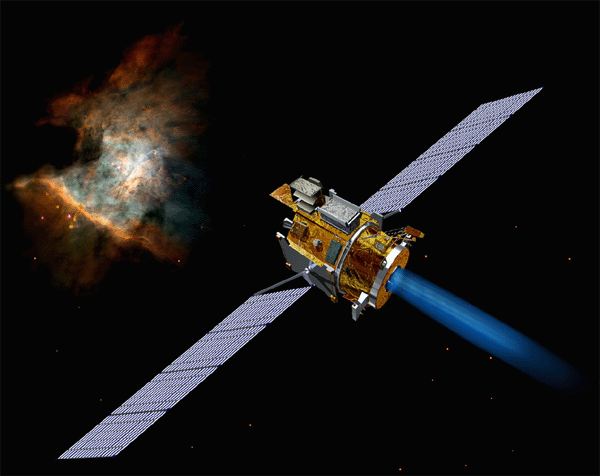






Selected Articles from the
September 2001 Odyssey
Editor: Terry Hancock
- Robotics Aboard Space Station Alhpa, Steven Bartlett
- "Never Give Up!", Robert Gounley
- The Surf Report, Diane Rhodes
"Never Give Up!"
by Robert Gounley
The destruction inflicted upon New York and Washington touched every American this week. We all feel the loss, not only of so many innocent lives, but also of a sense of security that such things can not happen here. We now know differently.
Now it is time to regroup and to prepare for future attacks. To that end, NASA's Jet Propulsion Laboratory closed for business while new security measures were put into place. For two days, the Lab was a very quiet place
In the midst of all this, the Deep Space 1 team continued their work, however. DS1, is not a scientific spacecraft in the classical mold. The scientific instruments onboard are themselves test articles to see how well they may perform on future missions where science is the objective. Any discoveries DS1 makes are a bonus.
Earlier articles describe attempts the DS1 team made in 1999 to take pictures of a near-Earth asteroid (see Reading Braille). The extreme darkness of its surface frustrated plans for the camera to track it during the encounter and take high-resolution images. The results, a few blurred pictures, were scientifically interesting, but attracted little media attention.
 |
| Artist's conception of spacecraft DS1 in flight. |
Nonetheless, NASA decision-makers saw potential. I would cost very little to keep DS1 flying. Within the capabilities of its ion engine (a first for deep space missions) were two comets whose paths DS1 could intercept. To date, no American spacecraft has ever flown close to a comet. A spacecraft called Stardust, specifically built to capture a comet sample, will not reach its destination until 2004. DS1 could visit one comet, Comet Wilson-Harrington, in 2000 and a second, Comet Borelly, in 2001. Capturing even a few pictures or measurements of a cometary plume would be a valuable contribution. In 1999, DS1 was granted funding to continue its mission.
The good news was only a few months old when the DS1 team faced a new problem. The Star Tracker failed suddenly and would not respond to repeated attempts to revive it. Without stars to guide it, DS1 could only place itself into a slow spin and point towards the sun, awaiting help from the Earthbound operators.
With effort, ground controllers could monitor the strength of DS1's radio signal and use it to roughly infer spacecraft position directly throughout a revolution. With careful timing, DS1's thrusters could be briefly fired to change direction slightly. By these halting steps, the spacecraft could eventually be pointed where desired.
It is not enough, however, to be able to direct a spacecraft only when the flight team is watching. Unable to point its ion engine in the proper direction, DS1 had lost its ability to intercept Comet Wilson-Harrington. If a way could not be found to operate DS1 without a star tracker, any chance of visiting Comet Borrely would be lost as well.
Fortunately, DS1 has its science camera. It can see stars, but the camera was designed to take close-up pictures of objects relatively far away. It would have to find its way by identifying stars through a view little wider than looking through a soda straw. Worse, if DS1 were to meet its appointment, it would need the new software ready and operational faster than rigorous testing would allow. The software had to work right the first time.
The programmers worked many nights to be ready. To the delight of everyone, the software worked. DS1 was on its way for a 22 September 2001 rendezvous with Comet Borelly.
That's why the DS1 flight team was still working while the rest of JPL lay dormant. There are still mid-course corrections to make to be sure comet and spacecraft cross paths where desired. Even with the considerable talents of the flight team, the Mission Manager readily admits that full success is a long shot. The comet will move quickly past DS1 and there are only minutes to get a picture of the elusive nucleus. Even a tiny pointing error will produce a picture of the fuzzy coma or, worse still, black sky. This would be challenging even if DS1 were fully operational.
Still, a plucky determination keeps the flight team going. They've embraced the motto of Galaxy Quest's Commander Taggart - "Never give up, never surrender!" Soon we'll all know if their efforts will be rewarded.
With so much horrific news about us, the exploits of a small team working in a vast government agency may not deserve much attention. The brave men and women risking their lives to rescue survivors in collapsed buildings are far more deserving. Yet, the small stories of quiet resolve to overcome obstacles speak to us. We will grieve, but we can still move forward.
When future generations look upon the rebuilt New York skyline and watch a space colony named Manhattan pass overhead, they may believe the concrete and steel were the legacy of our age. How wrong that would be. It is the determination and courage and faith of many people working together that makes great things possible. Our monument should be a steadfast determination to make safe the world we now live upon and to build new ones where Mankind can grow.
We can all contribute to that.
File translated from TEX by TTH, version
2.25.
On 20 Jan 2002, 16:32.
Copyright © 1998-2003 Organization for the Advancement of Space Industrialization and Settlement. All Rights Reserved.